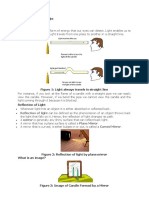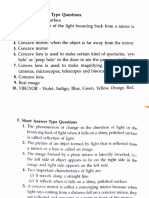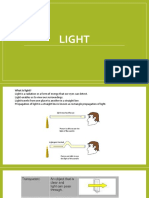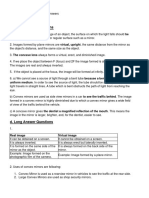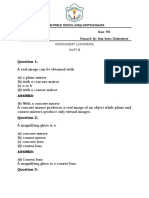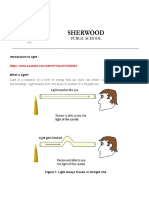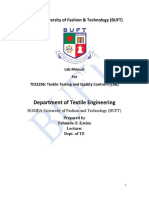CH: LIGHT Q1. Define :- A) Light: Light is a form of energy that enables us to see the objects.
B)
Reflection of Light: The change in direction of a ray of light on striking a surface is called the
reflection of light. Note: A highly polished or shiny surface reflects most of the light falling on it.
C) Refraction of Light: The bending of light as it passes from one medium to another. (example:
from air to water) D) Object (in Physics): Anything that gives out light rays is called an object. For
example, a bulb, candle or the Sun. E) Image: An image is an optical appearance formed when
light rays coming from an object are reflected from a mirror. F) Screen: A flat surface on which
an image can be seen. Example: a piece of white cloth, the human retina, a TV screen. Q2. What
is meant by Rectilinear Propagation of Light? Explain with diagram how does light travel? A2.
The property of light to travelling in a straight line is called rectilinear propagation of light. Note:
Light always travels in a straight line in a uniform medium. (leave 7 lines for the diagram) Q3.
Name the two types of Images. Differentiate between them. A3. Images can be either real or
virtual. Real Images Virtual Images -Can be obtained on a screen. -Cannot be obtained on a
screen. -Always inverted (upside down). -Always erect (right-side up). Q4. What do you mean by
the term mirror? A4. A mirror is a highly polished surface that reflects a significant amount of
light falling on it. Note: A smooth surface is essential for clear reflection. Q5. What are the
characteristics of the images formed by a Plane mirror? A5. The images formed by a plane
mirror are: 1. Virtual and erect. 2. Same size as the object. 3. At the same distance from the
mirror as the object is in front of the mirror. 4. Laterally inverted (left appears as right and vice
versa). Q6. Why is the mirror image of ‘AMBULANCE’ written on the Vehicle? A6. The mirror
image of the word "AMBULANCE" is written on the vehicle so that when the driver of the
vehicle ahead of the ambulance looks into their rearview mirror, they can read the word
correctly and give way to the ambulance. Q7. What are Spherical mirrors? A7. Spherical mirrors
or curved mirrors are mirrors with reflecting surfaces as the part of a sphere. There are two
types: • Concave mirror (curved inward) • Convex mirror (curved outward) Q8. What is a
Concave mirror? List its uses. A8. A concave mirror is a spherical mirror whose reflecting surface
is curved inward. Uses of a Concave Mirror: 1. Used as a shaving mirror to magnify the image. 2.
Used by dentists to see an enlarged image of teeth. 3. Used in headlights of vehicles, torches,
and searchlights to focus light into a powerful beam. Q9. What Are the Characteristics of an
Image Formed by a Concave Mirror? • When the object is very close to the concave mirror, a
magnified, erect, and virtual image is formed. • As the object is moved farther away, the image
becomes smaller and real, and is inverted. Q10. What is a Convex Mirror? List Its Uses. A10. A
convex mirror is a spherical mirror whose reflecting surface is curved outward. Uses of a Convex
mirror: 1. Rearview mirrors in vehicles: It provides a wider field of view. 2. Security mirrors in
stores or parking lots to monitor large areas. Q11. What are the characteristics of an image
formed by a Convex mirror? A11. Convex mirror always form virtual, erect, and diminished
images, regardless of the distance between the object and the mirror. Q12. What is a Lens?
Name Its Types. A12. A lens is a curved piece of glass that makes objects appear larger or
�clearer when we look through it. There are two main types of lenses: 1. Convex lens (converging
lens) 2. Concave lens (diverging lens) Q13. Define a Convex Lens. Why is it called a converging
lens? A13. A convex lens is thicker in the middle and thinner at the edges. It is called a
converging lens because it converges (brings together) light rays falling on it at a single point.
Convex lenses are commonly used as magnifying glasses. Q14. Define a Concave Lens. Why is it
called a diverging lens? A14. A concave lens is thinner in the middle and thicker at the edges. It
is called a diverging lens because it causes the light rays falling on it to diverge (spread apart).
Q15. What is White Light? A15. White light is a mixture of seven colors Violet, Indigo, Blue,
Green, Yellow, Orange, Red. Q 16. What is Dispersion? A 16. Dispersion is the process by which
white light is separated into seven colors when it passes through a medium, like a prism. For
example, when white light passes through a triangular prism, it splits into the colors of the
rainbow: violet, indigo, blue, green, yellow, orange, and red (VIBGYOR). Assertion/Reasoning
Questions: (Leave about 2 lines for the answers to be answered in the class) 1. Assertion: Light
travels along a straight line. Reason: White light is composed of 7 colors. Ans: 2. Assertion:
When the object is placed very close to the concave mirror, the image formed is virtual, erect,
and magnified. Reason: This happens because the concave mirror can form real and inverted
images when the object is placed far from the mirror. Ans: 3. Assertion: Shadow has no color.
Reason: Shadow is formed behind the object. Ans: 4. Assertion: A converging lens separates the
light falling on it. Reason: A convex lens is used as a magnifying glass. Ans: Case Study :
Reflection and Plane Mirrors Rita stands in front of a plane mirror in her room. She notices that
the image in the mirror is the same size as herself, upright, and appears to be at the same
distance from the mirror as she is. Questions: 1. What type of image is formed in the plane
mirror in Rita’s case? Explain why? 2. How does the distance of the image from the mirror
compare to the distance of the object (Rita) from the mirror? 3. What is meant by the term
“lateral inversion” in the context of the image formed in the mirror? 4. If Rita moves closer to
the mirror, how will the image appear?




